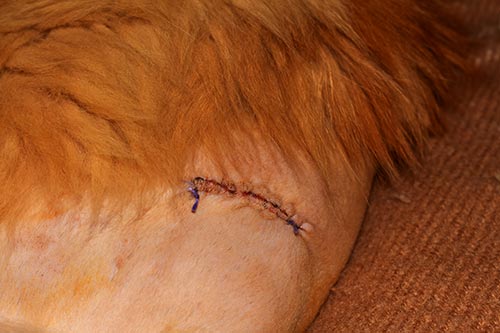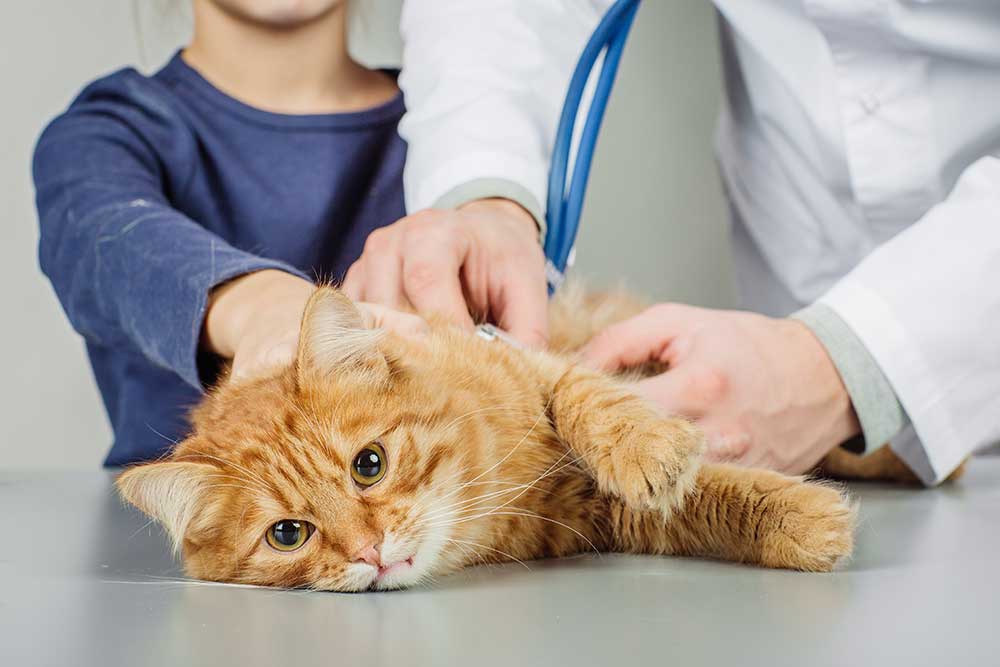Through my experience as a veterinary surgeon dealing with cat incisions and complications, I understand the importance of being vigilant about your cat’s post-surgical wound care. Knowing how to distinguish between normal healing and signs of infection can be life-saving for your furry companion.
As a cat owner, it’s important to monitor your cat’s incision after surgery to ensure proper healing and avoid potential complications.
Cats may undergo various types of surgery, such as spaying, neutering, mass removal, or wound repair, and knowing the difference between a normal incision and an infected one is crucial. This article will guide you through recognizing the signs of a normal incision and identifying potential problems like infections, ultimately allowing you to keep your feline friend healthy and pain-free.
So, let’s dive into what a normal incision looks like, how to spot infection, common incision issues, and when it’s time to consult your veterinarian for professional help.
What Normal Incisions Look Like (With Pictures)
A normal incision on your cat after surgery would typically appear clean and closed, with the skin being a normal or slightly reddish-pink color. The incision’s shape and size depend on the type of surgery, but generally, it should be straight with the sutures holding the skin edges together neatly. The skin around the incision may show a small amount of bruising in pale-skinned cats, but this is normal during the initial healing process.
– The healing process of a normal cat incision takes place in stages:
1. Inflammation: The initial stage is inflammation, which occurs in the first few days after surgery. During this period, the body responds to the injury by increasing blood flow to the area, leading to slightly redder and swollen skin around the incision.
2. Granulation: Next comes the granulation stage, wherein new tissues and blood vessels form, providing a foundation for the final scar. This phase generally occurs within 10-14 days after the surgery.
Consequently, a permanent scar forms within 14-21 days, marking the completion of your cat’s incision healing process.
Here are some pictures of normal incisions from different types of surgeries, such as cat spays and other procedures. You can use these images as a reference to compare your cat’s incision and monitor its progress.



Keep in mind that the exact appearance of a normal incision might vary depending on factors like the surgery type, its location, your cat’s age and overall health, and the surgeon’s technique. Nonetheless, it is essential to keep a close eye on your cat’s incision and consult your vet if you notice any abnormal signs.
In summary, a normal cat incision should appear clean, closed, and with a reddish-pink color during the healing process. This process typically takes 14-21 days, with some minor variation depending on individual factors. If you have concerns about your cat’s incision, don’t hesitate to reach out to your veterinarian for guidance and support.
What Incision Infections Look Like in Cats (With Pictures)
An infected incision in cats generally appears swollen, red, or discolored, and may have discharge such as pus or blood. The skin and sutures around the incision might be inflamed, sensitive to touch, and warmer than the surrounding area.
Incision infections in cats are often caused by bacteria, foreign material/dirt, poor hygiene during the healing process, or excessive licking or scratching by the cat. A weak immune system can also increase the risk of infection.
Here are some pictures of infected incisions from different types of surgeries:

You can also view this picture or this picture on iStockPhoto showing other good examples of infected wounds on cats.
It’s important to note that infected incisions can vary slightly depending on factors such as the type and severity of infection, the cat’s immune system response, and the treatment given. If you suspect your cat’s incision may be infected, consult your veterinarian to determine the best course of action to ensure a safe and effective recovery.
Signs That Your Cat’s Incision Is Infected
Sometimes it can be difficult to determine if your cat’s incision is healing normally or if an infection has set in.
One of the first signs that your cat’s incision may be infected is redness or swelling around the incision site. While some redness is expected during the initial healing process, excessive redness and swelling that increases over time indicate a potential infection.
Another sign to look out for is pain or tenderness when touching the incision. If your cat reacts negatively or shows signs of discomfort when you gently touch the area, this can be a warning sign of infection.
You may also notice warmth or heat coming from the incision. An infected incision may feel warmer to the touch compared to the surrounding skin, signalling the body’s immune response fighting the infection.
A foul odor or pus coming from the incision is another indication that the incision may be infected. The presence of pus or a foul smell suggests the accumulation of bacteria and dead tissue at the site.
In addition to changes of the incision site itself, keep an eye out for general signs of infection, such as:
- Fever
- Lethargy
- Loss of appetite
- Weight loss
These symptoms can be indicators that your cat’s body is fighting an infection, and prompt veterinary attention is required.
Key Signs of Incision Infections
- Swelling and Redness – A little bit of swelling and redness around the incision site is normal, but if it seems excessive or the redness expands over a large area, that might indicate an infection brewing. If you notice extreme redness or swelling, it’s time to call your vet for a checkup. This picture on iStockPhoto shows a good example of swelling and redness that might be signs of an infection.
- Heat and Fever – A warm incision area can be a sign of inflammation, while fever might point to an infection. Your cat may also become lethargic or disinterested in their usual activities if they have a fever. Don’t hesitate to check with your vet if you suspect something isn’t right.
- Pus and Discharge – A healthy incision shouldn’t discharge any pus or excessive fluid. If you observe drainage from the area, particularly pus or blood, it’s a signal that your cat might have an infection that needs to be treated. See this example picture on TheCatSite.com forum.
- Erythema Persistent redness, also known as erythema, is not a normal part of the healing process. Erythema might indicate an infection or irritation, so keeping an eye on it and consulting your vet is crucial. See this example picture on TriPaws.com.
These are the key signs to watch for while your cat’s incision is healing after surgery. Don’t forget that if you have any doubts or concerns, it’s always best to contact your veterinarian for professional advice. Your furry friend will thank you for paying attention to their health and ensuring they recover smoothly from their surgery.
Other Signs That Your Cat’s Incision Is Not Healing Well (Common Incision Issues)

In addition to the common signs of infection such as redness, swelling, and discharge, there are several other indicators that your cat’s incision might not be healing well. Let’s take a look at some of these signs and the related complications.
Bleeding or Bruising
Bleeding from the incision site can be a sign of trouble, especially if it’s continuous or excessive. Bruising around the area might also indicate an issue underneath the skin that requires attention. Keep an eye on the wound, and if you notice either of these conditions, it’s best to consult your veterinarian.
Missing or Broken Sutures/Staples
Sutures and staples serve as the means to keep the incision closed, so if they’re missing or broken, the wound may not heal properly. This can be a result of your cat licking or scratching at the incision, which can introduce bacteria and increase the risk of infection. Contact your vet if you notice any missing or broken sutures/staples.
Wide Gap or Separation Between Incision Edges
A wide gap (usually over ¼ inch) between the edges of the incision is a cause for concern, as it can indicate a complication called dehiscence. Dehiscence is when the wound reopens, exposing the underlying tissues and increasing the risk of infection. If you notice a wide gap, contact your veterinarian immediately.
Tissue Protrusion from Incision
If any tissue is protruding from the incision, this is a clear sign that something is not right. Reach out to your vet as soon as you notice this issue.
Seroma or Hematoma Formation
Seromas and hematomas are fluid-filled pockets that can form beneath the incision, usually resulting from excessive bleeding, bruising, or a reaction to the sutures. While not always indicative of complications, untreated seromas and hematomas can prolong the healing process. Monitor the area, and consult your veterinarian if you suspect any of these issues.
Surgical Drain Problems
Some surgeries involve the placement of a surgical drain to help remove excess fluid. If the drain is not functioning properly or has become dislodged, it can delay healing and increase the risk of complications. If your cat had a surgical drain and you observe issues, contact your vet for further guidance.
Being aware of these additional signs and complications can help ensure that your cat’s incision heals properly. If you ever have concerns about your cat’s healing process, don’t hesitate to reach out to your veterinarian for advice and support.
Signs that Your Cat Needs a Veterinarian’s Help
There are a few key indications that your cat’s incision might need professional attention. It’s essential to act promptly and contact your vet if you notice any of these signs:
Lethargy: While it’s normal for your cat to be a bit less active after surgery, excessive lethargy could indicate a problem with their incision. If your cat seems weak or tired despite getting enough rest, it’s worth having a veterinarian check them out.
Fever: A fever could be a sign of infection or other complications. Monitor your cat’s temperature and contact your veterinarian immediately if it’s elevated.
Dehiscence: If separation of the incision occurs, you should definitely be concerned. This can happen if your cat has been too active or has been licking or scratching at its site. Dehiscence can lead to a more complicated healing process, so seeking professional help is essential.
Septicemia: Pay attention to your cat’s overall behavior. If you observe any signs of septicemia, such as a sudden decrease in appetite, rapid breathing, or a change in their gum color, it’s essential to contact a veterinarian right away. Septicemia is a severe, life-threatening condition that requires immediate attention.
How Your Vet Can Help
Questions Your Vet Will Ask You
When you bring your cat to the vet for an incision check-up, they will start by asking you questions about your cat’s history, symptoms, and behavior. This will help the vet determine if there are any complications or infections concerning the incision. They may ask about any changes in your cat’s activity level, appetite, or demeanor since the surgery. If they have any other symptoms or if they have been licking at the wound. Having the answers to these questions at the ready will help speed up the recovery process.
What You Should Know Before Your Visit
Before visiting the vet, make sure to monitor your cat’s incision site closely. It’s important to know if the incision is healing properly, or if there are any signs of infection, such as increased redness, swelling, or discharge. Also, make a note of any abnormal behaviors, like excessive licking or chewing at the incision site, as this could be a sign of discomfort or irritation.
Diagnosis & Cost of Diagnosis
To diagnose any complications with the incision, your vet will thoroughly examine the incision site and surrounding area. They may take a sample of fluid or tissue from the incision for testing (culture, cytology, biopsy) or perform blood tests and other diagnostic tests to assess your cat’s overall health and immune system function. The cost of diagnosis for common incision problems in cats can vary depending on the tests required and the severity of the issue but may be anywhere between $50-300.
Vet Treatments & Costs
If your cat’s incision is infected, your vet will likely prescribe antibiotics. There are different types of antibiotics – oral antibiotics and topical antibiotics – and the vet will choose the most appropriate one depending on the severity of the infection and the specific bacteria involved. In some cases, surgical debridement may be necessary to remove any dead tissue and promote the healing process.
The cost of these treatments will depend on the type and course of antibiotics, along with any additional tests or interventions needed to manage complications but can range from anywhere between $100 for small medical interventions, to $500+ if repeat surgery is required. It’s important to discuss the estimated costs with your vet, as the total cost can vary greatly based on your location and the specific requirements of your cat’s diagnosis and treatment.
Prognosis
With timely diagnosis and proper treatment, most cats recover well from incision infections. The recovery period can vary depending on the severity of the infection and any additional complications. During the healing process, it’s essential to follow your vet’s instructions regarding medication and care to ensure the best possible outcome for your cat.

